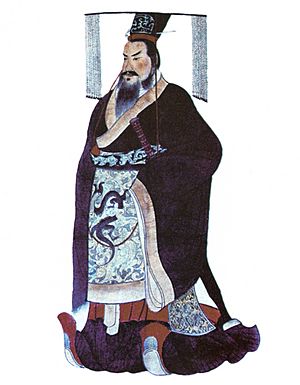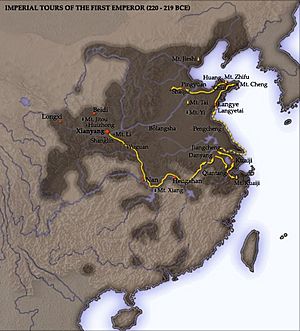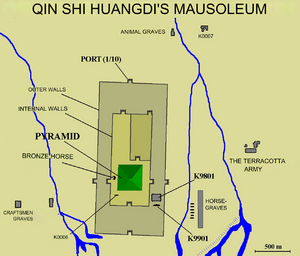Qin Shi Huang facts for kids
Quick facts for kids Qin Shi Huang |
|||||||||
|---|---|---|---|---|---|---|---|---|---|

Imaginary depiction of Qin Shi Huang, 19th century
|
|||||||||
| Emperor of the Qin dynasty | |||||||||
| Reign | 221 – 210 BC | ||||||||
| Successor | Qin Er Shi | ||||||||
| King of Qin | |||||||||
| Reign | 6 July 247 BC – 221 BC | ||||||||
| Predecessor | King Zhuangxiang | ||||||||
| Successor | Position abolished (Himself as Emperor) | ||||||||
| Born | Ying Zheng (嬴政) or Zhao Zheng (趙政) February 259 BC Handan, Zhao |
||||||||
| Died | 12 July 210 BC (aged 49) Shaqiu, Qin dynasty |
||||||||
| Burial | Mausoleum of the First Qin Emperor | ||||||||
| Issue |
|
||||||||
|
|||||||||
| House | Ying | ||||||||
| Dynasty | Qin | ||||||||
| Father | King Zhuangxiang | ||||||||
| Mother | Queen Dowager Zhao | ||||||||
Qin Shi Huang (Chinese: 秦始皇, Qín Shǐ Huáng) was a very important leader in ancient China. He lived from 259 BC to 210 BC. He founded the Qin dynasty and became the first emperor.
Instead of being called "king," like earlier rulers, he created a new title: "emperor" (huángdì 皇帝). This title was used by Chinese rulers for the next two thousand years. Qin Shi Huang is famous for uniting all of China and for his huge building projects. These include parts of the Great Wall of China and his amazing Terracotta Army.
Contents
Who Was Qin Shi Huang?
Qin Shi Huang was born as Ying Zheng (嬴政) in Handan, the capital of the Zhao state. His parents were King Zhuangxiang of Qin and Lady Zhao. A rich merchant named Lü Buwei helped him become king after his father died.
Early Life and Rise to Power
Becoming King of Qin
In 246 BC, when he was just 13 years old, Ying Zheng became the King of Qin. His father, King Zhuangxiang, had ruled for only three years. Because he was so young, Lü Buwei acted as his main advisor and prime minister.
Nine years later, in 235 BC, King Zheng took full control of the Qin state. He was a strong and determined leader.
Unifying China
The time before Qin Shi Huang was known as the Warring States period. Many different states were constantly fighting each other. King Zheng wanted to unite all of these states under one rule.
Starting in 230 BC, King Zheng began his final military campaigns. He conquered the weakest state, Han, first. Then, he defeated Zhao, Yan, Wei, and Chu. Finally, in 221 BC, he conquered the state of Qi. This brought an end to the long period of warfare.
By 221 BC, all the lands of China were unified under the Qin state. King Zheng then declared himself the "First Emperor" (Shǐ Huángdì). He believed this new title showed his power and importance. He wanted his empire to last forever.
The First Emperor's Rule
New Ways to Govern
Qin Shi Huang and his minister Li Si made many changes to how China was governed. They wanted to prevent the country from breaking apart again. They divided the empire into smaller administrative units called commanderries and counties.
Leaders for these units were chosen based on their skills, not their family background. This helped create a strong central government.
Standardizing China
The Emperor also made sure that many things were the same across China. This helped trade and communication.
- He standardized weights and measurements.
- He made sure all wagon axles were the same length. This made travel on roads easier.
- He created a new national road system and canals.
- He standardized the money, using the Ban Liang coin.
- He unified the way Chinese characters were written. This meant everyone in China could read the same written language, even if their spoken dialects were different.
Great Building Projects
Qin Shi Huang was famous for his massive building projects.
- The Great Wall: He ordered the destruction of old walls that divided the former states. Then, he connected existing fortifications in the north to create a new, longer wall. This wall protected China from northern nomadic groups like the Xiongnu. Hundreds of thousands of workers helped build this early version of the Great Wall of China.
- Lingqu Canal: In 214 BC, he started building a 34-kilometer canal. This canal connected two major rivers, helping with trade and moving military supplies. It was a huge engineering achievement.
- Monumental Statues: After uniting China, he collected all the bronze weapons from the conquered states. He melted them down to create twelve giant bronze statues for his palace.
Search for Immortality
As he got older, Qin Shi Huang became very interested in finding an elixir of life. He wanted to live forever. He sent people on expeditions to find magical islands and powerful magicians.
One famous story tells of Xu Fu. The Emperor sent Xu Fu with many young men and women to find the mystical Mount Penglai. They never returned. Some legends say they reached and settled in Japan.
Challenges and Later Years
Facing Threats
King Zheng faced several attempts on his life before he became emperor.
- In 227 BC, Crown Prince Dan of Yan sent two assassins, Jing Ke and Qin Wuyang. They tried to stab the king during a meeting, but the attempt failed.
- Later, a friend of Jing Ke, Gao Jianli, tried to kill the Emperor with a weighted musical instrument. This attempt also failed.
- In 218 BC, a former aristocrat named Zhang Liang hired a strongman. They tried to hit the Emperor's carriage with a heavy metal cone. The Emperor was in a different carriage, so he was safe.
The Emperor's Death and Succession
Qin Shi Huang made five long tours across his empire. During his last tour, in 210 BC, he became very ill and died at the age of 49. The exact cause of his death is not known. Some historians believe he might have been poisoned by elixirs containing mercury. These were given to him by alchemists who promised immortality.
After his death, there was a power struggle. His chief minister, Li Si, and a powerful eunuch, Zhao Gao, worked together. They made sure that the Emperor's younger son, Huhai, became the next emperor. This happened instead of his eldest son, Fusu, who was supposed to rule.
Family of Qin Shi Huang
Qin Shi Huang had many children, but most of their names are not known today. He had about 30 sons and 15 daughters. He never named an empress.
His known family members include:
- Parents: King Zhuangxiang of Qin and Queen Dowager Zhao.
- Half-brother: Chengjiao, Lord of Chang'an.
- Sons: Fusu (his eldest son), Gao, Jianglü, and Huhai (who became the Second Emperor).
Lasting Legacy
The Terracotta Army and Mausoleum
One of Qin Shi Huang's most amazing legacies is his tomb. He started building it early in his reign. It was a massive project, meant to be his home in the afterlife.
The tomb is guarded by the famous Terracotta Army. These are thousands of life-sized clay statues of soldiers, horses, and chariots. They were discovered by farmers in 1974 near modern Xi'an. Each soldier has unique features. Their purpose was to protect the Emperor in the afterlife from evil spirits.
The main tomb where the Emperor is buried has not been opened yet. Ancient records describe it with replicas of palaces, rivers made of mercury, and traps to stop intruders. Modern tests have found high levels of mercury in the area, suggesting these stories might be true.
How History Remembers Him

Qin Shi Huang is remembered in different ways by historians. Some ancient Chinese historians saw him as a very strict and harsh ruler. They criticized him for his strong laws and for punishing scholars who disagreed with him. He also ordered many books to be burned, except for those about practical subjects like medicine and agriculture. This was done to control ideas and standardize knowledge.
However, many modern historians also praise him. They see him as a visionary leader who united China after centuries of fighting. His reforms created a strong, centralized government that shaped China for thousands of years. His building projects, like parts of the Great Wall, are still famous today. His actions had a huge and lasting impact on China's history.
Qin Shi Huang in Stories and Movies
Qin Shi Huang's story is so dramatic that he has appeared in many books, movies, and games.
- "The Wall and the Books" (La muralla y los libros) is an essay by Jorge Luis Borges.
- The Emperor's Shadow (1996) and The Emperor and the Assassin (1999) are films about his life.
- The movie Hero (2002) shows a fictional story of an assassination attempt on the King of Qin.
- The Japanese manga Kingdom (2006) tells a fictionalized story of his quest to unite China.
- He is a playable leader in the video game Civilization VI (2016).
- He appears in the mobile game Fate/Grand Order (2015) as a powerful servant.
- The Mummy: Tomb of the Dragon Emperor (2008) is a fantasy film where he is a cursed emperor.
See also
 In Spanish: Qin Shi Huang para niños
In Spanish: Qin Shi Huang para niños



